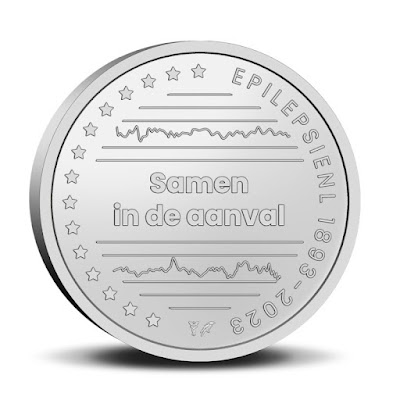2731) "EpilepsieNL" (Epilepsy), Netherlands: 130th Anniversary milestone (1893-2023): Two Coins/Medals in Coincard issued by the Royal Dutch Mint (RDM): Year of Coins issue: 2023:
The word "epilepsy" derives from Ancient Greek, "to seize, possess, or afflict":
Epilepsy is a group of non-communicable neurological disorders characterized by recurrent epileptic seizures.
An epileptic seizure is the clinical manifestation of an abnormal, excessive, purposeless and synchronized electrical discharge in the brain cells called neurons.
The International League Against Epilepsy has, in 2005 and again in 2014, published guidelines about the definition of epilepsy for operational purposes.
In the past epilepsy was defined as "2 or more unprovoked seizures with the understanding that this was an enduring condition that would repeat itself".
The new definition includes the "occurrence two or more seizures separated by 24 hours, or of a single seizure with a chance at recurrence after 2 seizures of greater than 60% in the next 10 years associated with the neurobiologic, cognitive, psychological and social repercussions of this condition".
Epileptic seizures can vary from brief and nearly undetectable periods to long periods of vigorous shaking due to abnormal electrical activity in the brain.
These episodes can result in physical injuries, either directly such as broken bones or through causing accidents.
In epilepsy, seizures tend to recur and may have no immediate underlying cause.
People with epilepsy may be treated differently in various areas of the world and experience varying degrees of social stigma due to the alarming nature of their symptoms.
The underlying mechanism of epileptic seizures is excessive and abnormal neuronal activity in the cortex of the brain which can be observed in the electroencephalogram (EEG) of an individual.
As of 2022 about 55 million people have epilepsy. Nearly 80% of cases occur in the developing world.
The Netherlands experience:
Yet, epilepsy brings a lot of fear and uncertainty: it can control a life completely. A seizure is almost always unexpected and can happen at any time, including in traffic or while cooking.
In collaboration with "EpilepsieNL", the Royal Dutch Mint has brought out a special Coincard issue:
Every year, the Royal Dutch Mint launches an issue for a good cause.
After the Mentality Foundation, KWF Fight Cancer and the ALS Foundation, EpilepsieNL was chosen.
The EpilepsieNL Coincard focusses on more visibility of the condition, because it is not always noticeable that someone has epilepsy.
The Coincard increases visibility for both epilepsy and the organisation.
About "EpilepsieNL":
"EpilepsieNL" is an organisation with only one goal - making the life of people with epilepsy better.
This is done through research into epilepsy, and also through education, recruitment and connecting people.
The organisation is celebrating its 130th Anniversary in 2023 - a long period in which many steps have already been taken.
"EpilepsieNL" keeps going on and is committed to do more research into treatments and better quality of life for people with epilepsy.
Two Coins/Medals in a Coincard:
The EpilepsieNL Coincard consists of not one but two Coins/Medals. Part of people with epilepsy cannot be alone either. They need a healthy person at their side to help them when a seizure occurs.
On the Obverse of both Coins/Medals, the head of a girl is shown; the brain is visible.
On the left Coin/medal is an image of a person’s brain without epilepsy.
The right Coin/Medal shows the same brain, but with UV-coloured dots. This is the brain of a person with epilepsy. The dots show the malfunctions in the brain, that occur with people who have epilepsy.
On the Reverse of the left Coin/Medal, the EpilepsieNL logo is shown and on the outer periphery the text: ‘130 jarig jubileum’, which means - "130th anniversary".
On the right Coin/Medal is the text ‘Samen in de aanval’, (which translates to ‘Standing together’).
This is the motto of the organisation.
Above and below this text, brainwaves of a person with epilepsy are shown.
The specifications of the individual Coins/Medals are:
Country: Netherlands; Year of Coins/Medals issue: 2023; Coins/Medals Theme: "EpilepsieNL" - 130th Anniversary (1893-2023)"; Metal Composition: Cupro-nickel (CuNi); Weight: 8.86 grams; Diameter/Size: 26.50 mm; Edge: Plain/Smooth; Coin/Medal Quality: Brilliant Uncirculated (BU); Mint: Royal Dutch Mint (RDM); Mintage: 5,000 pieces.
For other interesting posts on issues from the Royal Dutch Mint, Netherlands and PostNL, please visit the following links:
For interesting posts from the Caribbean Netherlands on this blog:
Posts on SEPAC issues on this blog:
Posts on Finland on this Blog:
Posts on Sweden:
Dutch Castles Coin Series:
Links:
The undernoted two links will take you to our blog "Footloose" for two interesting posts written by me on the Dutch presence in Sadras in the 17th Century AD:
5) City of Bruges (or Brugge), Belgium: 20 Years as UNENCO World Heritage Site: A 20 Euro Silver Proof Coin issued by the Royakl Dutch Mint under licencing of the Royal Belgian Mint, on behalf of the National Bank of Belgium: Coin issue date: 26.02.2020
6) 100 Years of Nature & Environment Protection, Luxembourg: Commemorating the Centenary Anniversary of the "Letzebuerger Natur a Vulleschutsliga a.s.b.l. (Luxembourg Nature and Bird Protection Society):A 0.80 Euro Stamp issued by Luxembourg Postes (Post): Date of stamp issue: 10.03.2020
7) Celebrating 25 Years of listing on UNESCO World Heritage Sites, Luxembourg: A Commemorative Stamp of 0.80 Euro issued by Luxembourg Postes (Post): Stamp issue date: 10.03.2020







Santosh Khanna has commented:
ReplyDelete"Thanks for sharing this interesting and informative post."
Thank you so much Khanna sahab.
DeleteRajan Trikha has commented:
ReplyDelete"Nice post 👍."
Thank you so much Trikha sahab.
Delete